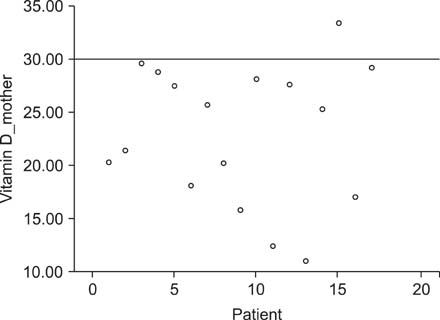Pediatr Gastroenterol Hepatol Nutr.
2014 Mar;17(1):47-51.
Neonatal Late-onset Hypocalcemia: Is There Any Relationship with Maternal Hypovitaminosis D?
- Affiliations
-
- 1Department of Pediatrics, Gyeongsang Institute of Health Science, Gyeongsang National University School of Medicine, Jinju, Korea. aroma@gnu.ac.kr
- 2Department of Rehabilitation Medicine, Gyeongsang Institute of Health Science, Gyeongsang National University School of Medicine, Jinju, Korea.
Abstract
- PURPOSE
Neonatal late-onset hypocalcemia is defined as hypocalcemia developed after postnatal 3 days and associated with hypoparathyroidism, high phosphate diets and vitamin D deficiency. We experienced the increment of neonatal late onset hypocalcemia over 1 year. We tried to evaluate the relationship between late onset hypocalcemia and maternal hypovitaminosis D.
METHODS
The medical records in the neonates with late-onset hypocalcemia during January 2007 to July 2008 were retrospectively reviewed. Among those patients, 17 paired sera of mothers and neonates had collected. The levels of 25-OH vitamin D (25OHD) and intact parathyroid hormone (iPTH) were measured and were compared with neonate and the mother.
RESULTS
The mean gestational age was 38+1 weeks, and the mean body weight was 2,980 g. The onset time of hypocalcemia was 5.9 days of age. Most of them (88.2%) were feeding with formula and no one was only breast milk feeding. Of the 17 patients, 13 were born in spring or in winter. The median levels of calcium, phosphorus, alkaline phosphatase, iPTH and 25OHD were 7.0 mg/dL, 8.6 mg/dL, 191.0 U/L, 57.2 pg/mL and 24.0 ng/mL in neonates. The levels of 25OHD of 6 neonates were <20 ng/mL. A total of 16 mothers were considered vitamin D-deficient (<20 ng/mL), and vitamin D insufficient (20<25OHD<30 ng/mL).
CONCLUSION
Neonatal late-onset hypocalcemia in our study seems to be influenced by maternal vitamin D deficiency and insufficiency. Sun tanning and vitamin D supplements from winter to spring would be helpful to prevent maternal vitamin D deficiency, one of the causes of neonatal late-onset hypocalcemia.
MeSH Terms
-
Alkaline Phosphatase
Body Weight
Calcium
Diet
Gestational Age
Humans
Hypocalcemia*
Hypoparathyroidism
Infant, Newborn
Medical Records
Milk, Human
Mothers
Parathyroid Hormone
Phosphorus
Retrospective Studies
Solar System
Tanning
Triacetoneamine-N-Oxyl
Vitamin D
Vitamin D Deficiency
Vitamins
Alkaline Phosphatase
Calcium
Parathyroid Hormone
Phosphorus
Triacetoneamine-N-Oxyl
Vitamin D
Vitamins
Figure
Reference
-
1. Salle BL, Delvin E, Glorieux F, David L. Human neonatal hypocalcemia. Biol Neonate. 1990; 58:Suppl 1. 22–31.
Article2. Lee CT, Tsai WY, Tung YC, Tsau YK. Transient pseudohypoparathyroidism as a cause of late-onset hypocalcemia in neonates and infants. J Formos Med Assoc. 2008; 107:806–810.
Article3. Thomas TC, Smith JM, White PC, Adhikari S. Transient neonatal hypocalcemia: presentation and outcomes. Pediatrics. 2012; 129:e1461–e1467.
Article4. Bodnar LM, Catov JM, Simhan HN, Holick MF, Powers RW, Roberts JM. Maternal vitamin D deficiency increases the risk of preeclampsia. J Clin Endocrinol Metab. 2007; 92:3517–3522.
Article5. Thomas SD, Fudge AN, Whiting M, Coates PS. The correlation between third-trimester maternal and newborn-serum 25-hydroxy-vitamin D in a selected South Australian group of newborn samples. BMJ Open. 2011; 1:e000236.
Article6. Specker BL, Valanis B, Hertzberg V, Edwards N, Tsang RC. Sunshine exposure and serum 25-hydroxyvitamin D concentrations in exclusively breast-fed infants. J Pediatr. 1985; 107:372–376.
Article7. Greer FR. 25-Hydroxyvitamin D: functional outcomes in infants and young children. Am J Clin Nutr. 2008; 88:529S–533S.
Article8. Bowyer L, Catling-Paull C, Diamond T, Homer C, Davis G, Craig ME. Vitamin D, PTH and calcium levels in pregnant women and their neonates. Clin Endocrinol (Oxf). 2009; 70:372–377.
Article9. Halicioglu O, Aksit S, Koc F, Akman SA, Albudak E, Yaprak I, et al. Vitamin D deficiency in pregnant women and their neonates in spring time in western Turkey. Paediatr Perinat Epidemiol. 2012; 26:53–60.
Article10. Khalesi N, Bahaeddini SM, Shariat M. Prevalence of maternal vitamin D deficiency in neonates with delayed hypocalcaemia. Acta Med Iran. 2012; 50:740–745.11. Dawodu A, Saadi HF, Bakdache G, Altaye M, Hollis BW. Extraordinarily high prevalence and lack of seasonal variationof vitamin D deficiency in pregnant Arab women. In : Pediatric Academic Societies Annual Meeting; 1-4 May 2010; Vancouver. E-PAS 2010. p. 1451.12. Kim HS. Calcium and phosphate metabolism and disorders in the newborn. Korean J Pediatr. 2007; 50:230–235.
Article13. Jain A, Agarwal R, Sankar MJ, Deorari A, Paul VK. Hypocalcemia in the newborn. Indian J Pediatr. 2010; 77:1123–1128.
Article14. Holick MF. The vitamin D epidemic and its health consequences. J Nutr. 2005; 135:2739S–2748S.
Article15. Heaney RP. Functional indices of vitamin D status and ramifications of vitamin D deficiency. Am J Clin Nutr. 2004; 80:6 Suppl. 1706S–1709S.
Article16. Rovner AJ, O'Brien KO. Hypovitaminosis D among healthy children in the United States: a review of the current evidence. Arch Pediatr Adolesc Med. 2008; 162:513–519.
Article17. Lewis PR. Disorders of calcium and phosphorus metabolism. In : Gleason CA, Devaskar SU, editors. Avery's diseases of the newborn. 9th ed. Philadelphia: Saunders;2012. p. 1257.18. Park SY, Park SW, Kang SK, Jun YH, Kim SK, Son BK, et al. Subclinical rickets in breastfed infants. Korean J Pediatr. 2007; 50:1188–1193.
Article
- Full Text Links
- Actions
-
Cited
- CITED
-
- Close
- Share
- Similar articles
-
- Maternal and Perinatal Outcomes of Early- and Late-onset Preeclampsia
- A study to compare maternal and perinatal outcome in early vs. late onset preeclampsia
- Causes and Clinical Features of Transient Hypocalcemia in Newborn: A Single Center Study
- Perinatal Risk Factors for Early Onset Hypocalcemia in Moderate-to-Late Preterm Infants
- Neonatal hypocalcemia: clinical manifestations and prognosis


